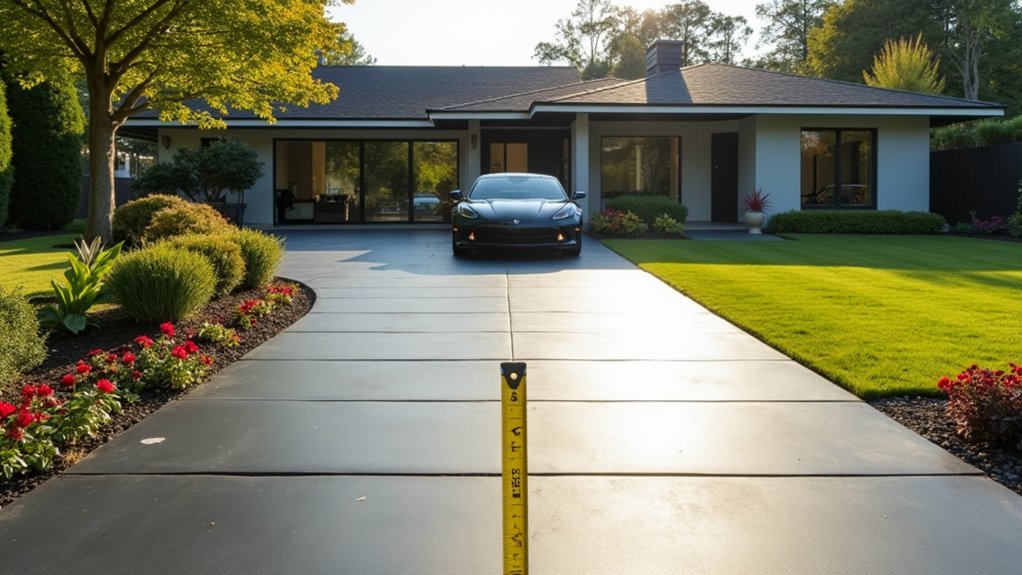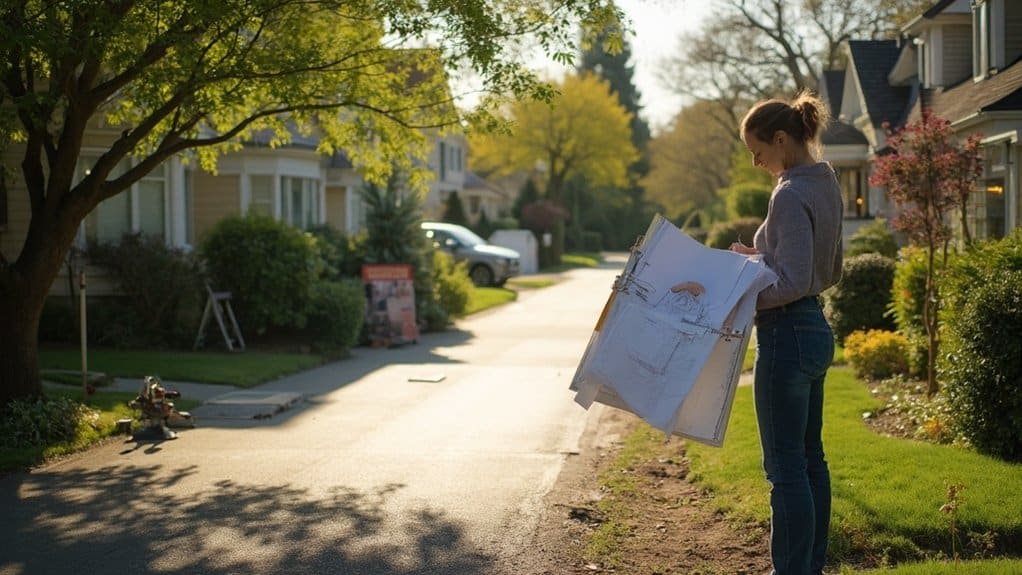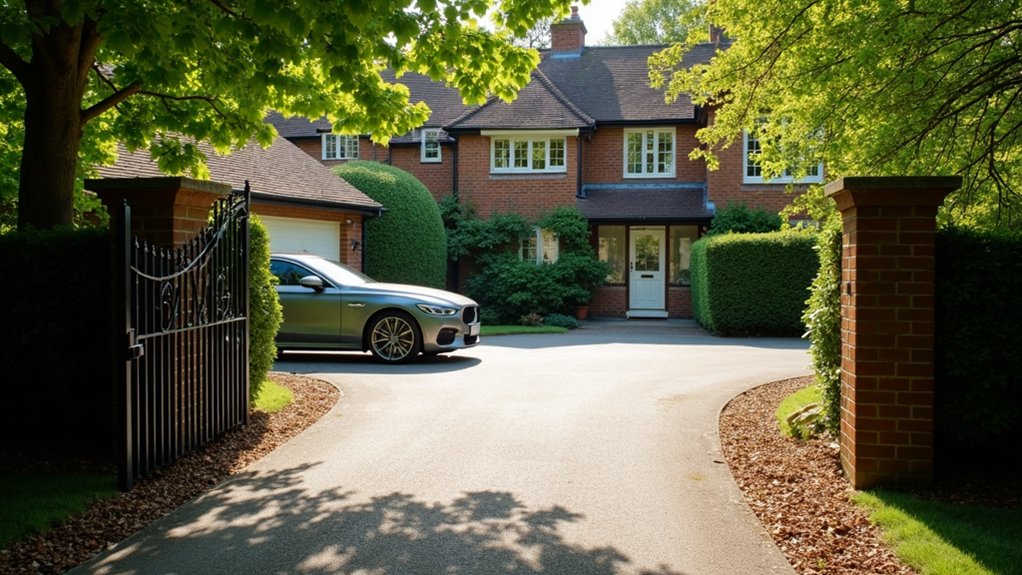Driveway width regulations differ depending on your location, vehicle type, and local zoning laws. Typically, residential driveways should be at least 3 metres (10 feet) wide. For shared driveways or those serving flag lots, the width can increase to 4.5 metres (15 feet). A single-car driveway should ideally be between 2.7 and 3.6 metres wide, whereas a two-car driveway needs to be a minimum of 5.5 metres. It’s important to check local regulations to ensure compliance and safety. For more detailed guidance on driveway design and regulations, be sure to explore further.
Table of Contents
ToggleKey Takeaways
Driveway Width Regulations: How Wide Can Your Driveway Be?
- Residential driveways usually need a minimum width of 3 metres (10 feet). For flag lots, this increases to at least 4.5 metres (15 feet).
- If you’re planning a driveway for two cars, aim for a minimum of 5.5 metres, but ideally between 6 and 7.3 metres for easier access.
- Local zoning rules might specify driveway widths based on the type of property, its use, and aesthetic factors.
- Consider the type of vehicles you’ll be parking; larger vehicles, like vans or 4x4s, typically need at least 3.6 metres to manoeuvre safely.
- There are often setback requirements as well, which usually call for at least 1 metre (3 feet) from your property boundaries to comply with local regulations.
Minimum Driveway Width Requirements
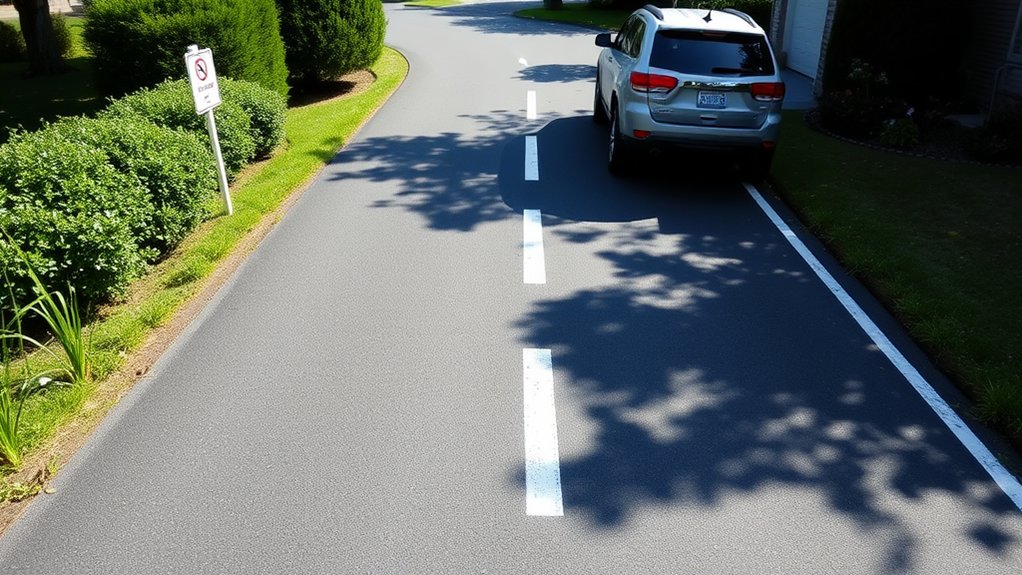
When considering minimum driveway width requirements in the UK, most residential driveways are usually set at a standard minimum width of 3 metres (approximately 10 feet). However, local variations can occur; for example, flag lots may require a minimum width of 4.5 metres (around 15 feet). Regulations might also stipulate different requirements for shared driveways, depending on how many properties they serve. Zoning regulations play a crucial role, as local codes can dictate widths based on property line restrictions and parking needs. Additionally, minimum driveway width requirements are typically enforced to ensure that driveways provide adequate space for vehicles to pass safely. Additional factors such as driveway length, obstructions, and access to the street can also influence these minimum width requirements. Understanding these regulations is vital for compliance, ensuring your driveway meets legal standards while also being safe and functional.
Recommended Widths for Different Vehicle Types
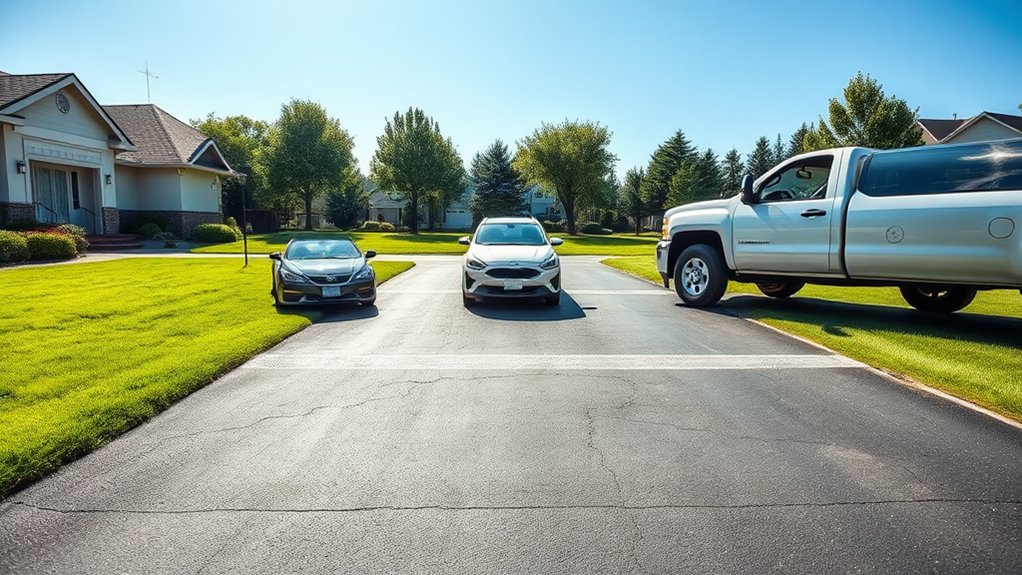
Understanding the recommended widths for different vehicle types is crucial for ensuring your driveway is both safe and functional. A well-designed driveway enhances vehicle accessibility and manoeuvrability.
Here are some essential width recommendations:
- Single-car vehicles: Aim for 2.7 to 3.6 metres for comfortable parking. A minimum width of 3.0 metres is ideal for better accessibility.
- Larger vehicles: At least 3.6 metres is advisable for work vans, trucks, and motorhomes.
- Multiple vehicles: A minimum of 5.5 metres is needed for a two-car driveway, with 6 to 7.3 metres being ideal.
- Longer vehicles: Extra width may be necessary for trailers and caravans.
Following these guidelines will help you construct a driveway that caters to your vehicle needs while ensuring safety and convenience for all users.
Zoning Regulations and Property Line Considerations
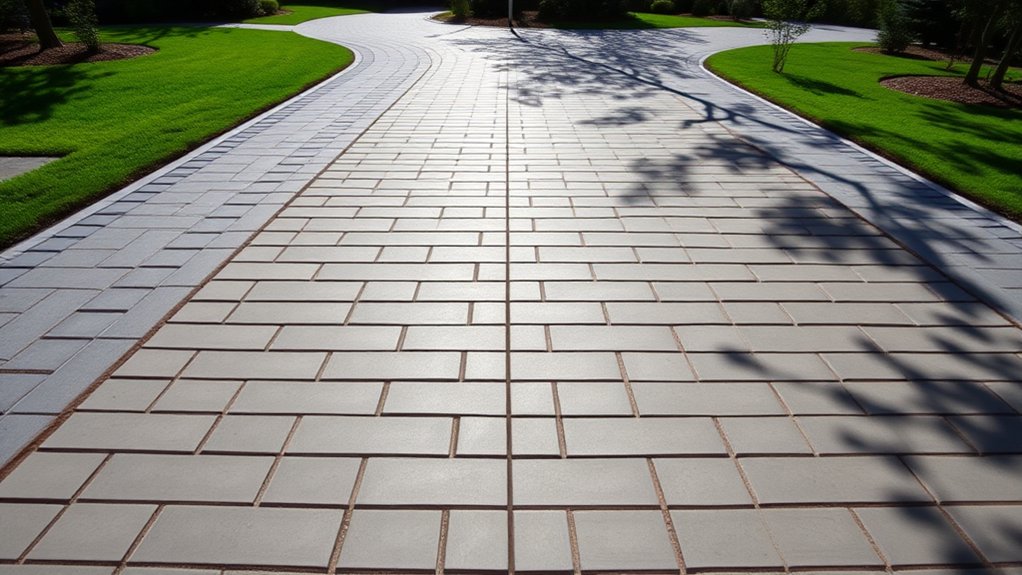
Zoning regulations are crucial for determining the width and layout of driveways, ensuring they meet local land use policies and community standards.
These regulations can differ significantly between local councils. For example, private driveways may be required to be at least 2.7 metres wide, while commercial driveways might need to be 3.6 metres.
It’s important to comply with width restrictions at the boundary line, usually not exceeding 9 metres. Additionally, local councils may enforce setbacks and minimum separations to maintain aesthetics and prevent overcrowding near property lines. Understanding these rules can help you design a driveway that’s compliant and enhances the look of your property within the community. Moreover, having access to expert answers can provide valuable insights into specific zoning requirements in your area.
Designing Driveways for Safety and Maneuverability
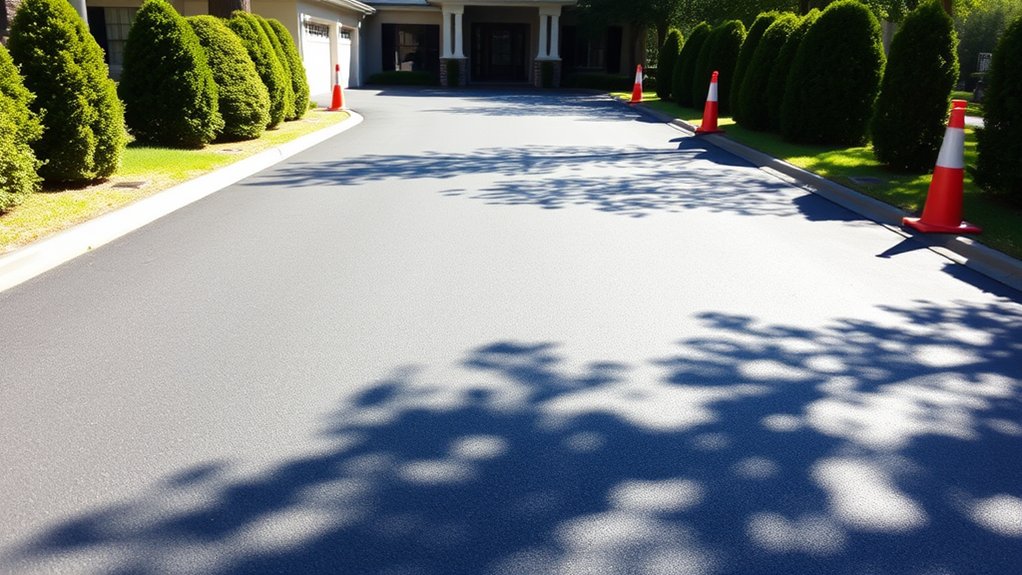
Driveway design is crucial for ensuring safety and ease of use, especially with local council regulations in mind.
Here are some key safety measures to improve vehicle navigation:
- Width: Ensure single-car driveways are between 2.7 to 3.6 metres wide, while two-car driveways should be 5.5 to 7.3 metres wide.
- Turning Radius: Choose wider driveways (4.3 to 5.5 metres) to facilitate manoeuvring larger vehicles.
- Visibility: Keep sightlines clear for safe entry and exit.
- Emergency Access: Design driveways to allow access for emergency vehicles, enhancing safety for everyone.
The Impact of Driveway Width on Aesthetics
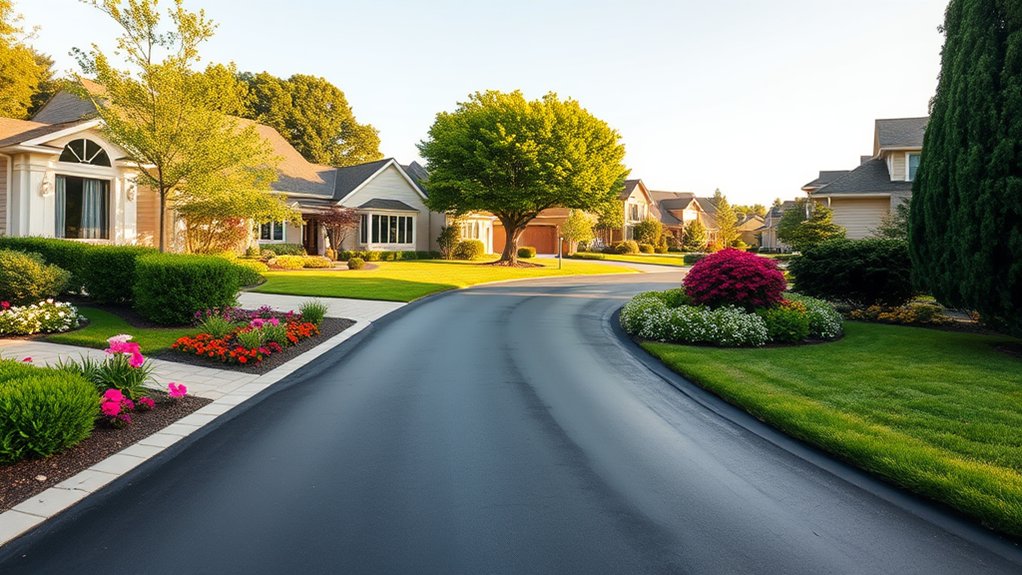
Driveway width has a significant effect on your property’s curb appeal, creating a visual balance with the home’s architectural style.
For instance, a wider driveway may suit a larger home, while a narrower one can complement a cottage-style property.
It’s essential that the driveway’s dimensions harmonise with both the house and the surrounding garden features.
This balance not only enhances aesthetics but also adheres to local regulations, ensuring a welcoming and attractive entryway.
Curb Appeal Enhancement
When considering curb appeal, the width of your driveway is crucial to the overall look of your property. A well-sized driveway can improve aesthetics and create a pleasing visual balance.
Here are four key factors to consider:
- Space for Vehicles: A wider driveway makes parking and manoeuvring much easier.
- Material Choice: The materials you select can significantly affect the driveway’s attractiveness and overall value.
- Landscaping Elements: Adding plants or decorative features can boost visual appeal.
- Local Standards: Ensuring your driveway width aligns with neighbourhood norms can prevent negative impressions.
Architectural Harmony Maintenance
To maintain architectural harmony, the width of your driveway should align with the scale and style of your home. Oversized driveways can disrupt the overall aesthetics and create a visual imbalance, overshadowing your home’s facade.
On the other hand, narrower driveways suit compact or traditional homes, preserving a sense of intimacy. For example, a wider driveway works well for a ranch-style home, while a more moderate width is ideal for a colonial property. Ensuring the proportions match your home’s style is key to a cohesive design. Properly sized driveways enhance rather than detract from your property’s scale.
Additionally, a symmetrical driveway layout reinforces architectural integrity and improves the overall appearance of your home. By carefully selecting your driveway width, you create a smooth transition from the street to your home, enhancing visual flow and preserving architectural unity.
Landscaping Integration Considerations
The width of a driveway is crucial for its functionality, but it also influences how well it blends with your landscaping.
To improve your property’s visual appeal, consider these landscaping principles:
- Balance Width and Space: A narrower driveway allows for planting beds, which can enhance the overall look of your home.
- Optical Effects: Planting near the edges can create the illusion of a narrower driveway, making it feel more inviting while calming traffic.
- Strategic Setbacks: Ensure there’s enough clearance for safety, but you can still keep the aesthetic in mind.
- Visual Interest: Adding islands or planting strips can break up large areas of pavement, making them more visually appealing.
Additionally, incorporating block paving can enhance the aesthetic appeal while providing durability for your driveway.
These straightforward tips can help you create a driveway that’s both functional and attractive.
Materials Used in Driveway Construction
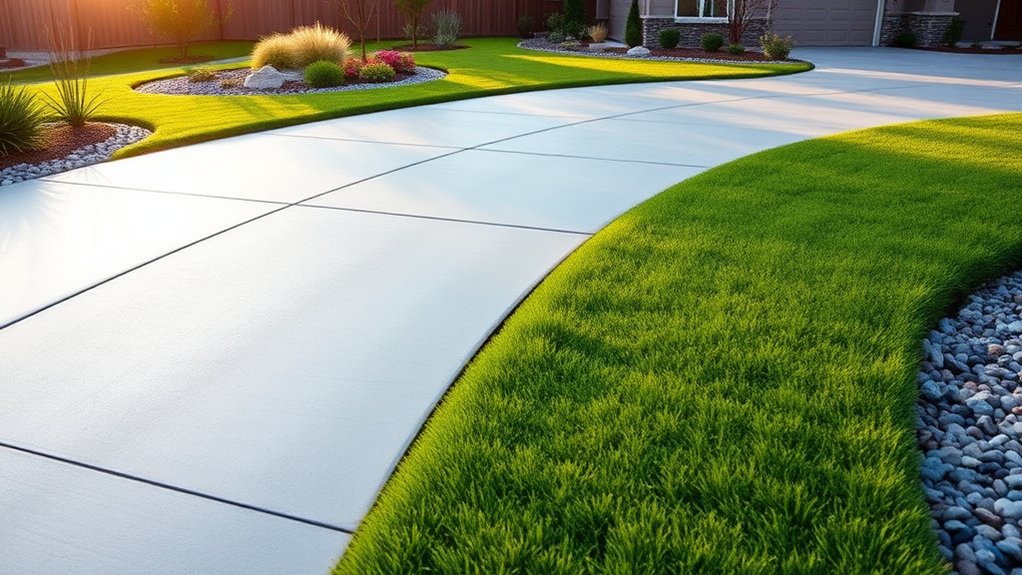
Materials used in driveway construction significantly influence the durability, maintenance requirements, and overall appearance of your property. Choosing the right material can greatly affect installation methods and long-term satisfaction. Here’s a concise comparison:
| Material | Cost (per sq. m.) | Lifespan |
|---|---|---|
| Asphalt | £40–£60 | 15–20 years |
| Concrete | £50–£120 | Several decades |
| Gravel | £10–£30 | Varies with upkeep |
Asphalt is a budget-friendly option but needs regular upkeep. Concrete, while more expensive initially, offers superior durability. Gravel is economical but requires periodic replenishment. For a decorative finish, brick or stone pavers are stylish but come at a higher cost. Choosing the right material is crucial for the performance and aesthetic appeal of your driveway. Additionally, understanding the long-term durability of different materials can help you make a more informed decision.
Construction and Permitting Process
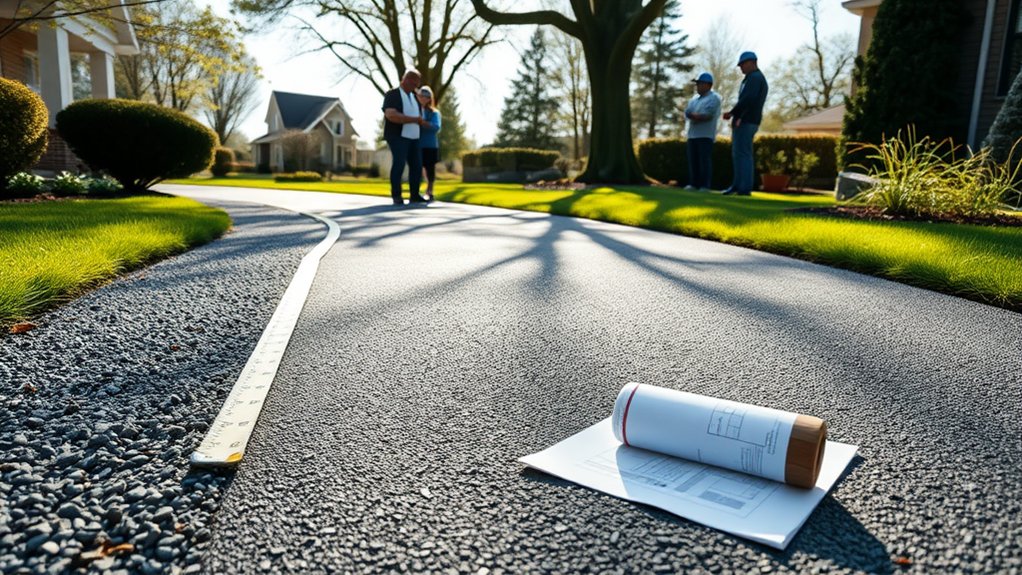
Before starting any driveway construction, it’s crucial to be aware of the regulations and permitting processes involved.
Navigating these requirements can present challenges, so it’s wise to manage permit timelines carefully.
Here are some key points to consider:
- Width Specifications: Ensure your driveway meets local width regulations, usually not exceeding 5.5 metres (approximately 18 feet).
- Setback Requirements: Check the minimum distance from property boundaries, which is typically around 1 metre (3 feet).
- Required Permits: Secure any necessary permits for structures associated with your driveway, such as patios or retaining walls.
- Environmental Regulations: Comply with additional guidelines from local environmental health authorities to prevent any delays.
Maintenance Considerations for Driveway Width
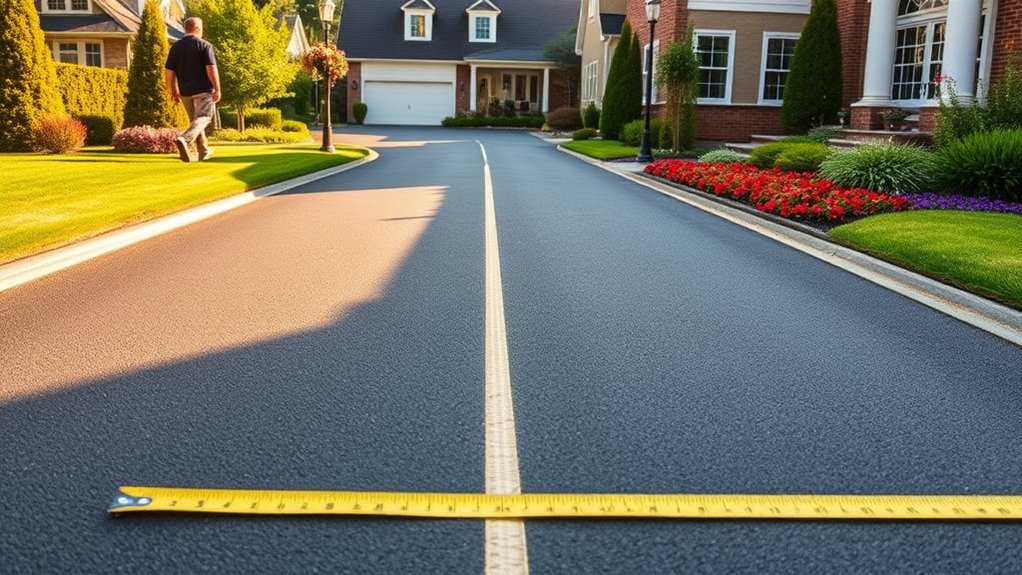
When considering driveway width, it’s important to factor in the wear and tear from everyday use, as incorrect dimensions can lead to increased damage.
Regular maintenance is vital for maintaining your driveway’s condition, affecting both safety and appearance.
For example, if your driveway is too narrow, you might find it difficult to park without risking scrapes on your car or damage to the surface.
Additionally, knowing the repair costs linked to insufficient width can help you make better choices about your driveway design and maintenance.
Wear and Tear
When considering the width of your driveway, it’s important to understand how it affects wear and tear over time. The longevity of your driveway depends on several factors related to its size.
Here are four key points to consider:
- Drainage: A wider driveway allows for better drainage, helping to prevent water buildup that can cause damage.
- Vehicle Movement: A broader surface facilitates smoother vehicle movement, which reduces stress and wear on the driveway.
- Material Choice: With a wider driveway, you can opt for thicker materials, making it more durable under heavy use.
- Weather Exposure: However, wider driveways may face more wear from sun and rain, potentially shortening their lifespan. Additionally, incorporating SuDS drainage systems during installation can further enhance the longevity and sustainability of your driveway.
Regular Maintenance Needs
Regular maintenance is crucial for keeping your driveway functional and looking good. By regularly inspecting it for cracks and wear, you can spot issues early and make repairs that can prolong its life.
Seasonal cleaning is important to prevent debris accumulation, which can cause damage over time. Depending on the material, you may need to patch asphalt or seal concrete.
It’s also vital to ensure proper drainage to prevent water pooling, which can weaken the structure. By following these maintenance tips, you not only improve your driveway’s appearance but also meet local safety and accessibility regulations, ensuring it aligns with community standards.
Cost of Repairs
Understanding the costs associated with driveway repairs is crucial for homeowners wanting to maintain or improve their property’s value. Here’s a quick cost breakdown:
- Average Asphalt Repair Costs: Between £800 and £3,200, with an average of £1,600.
- Repair Techniques: Common methods include filling cracks and patching potholes, which can be done as DIY projects or by professionals.
- Concrete Comparison: Concrete repairs average about £1,500, providing a different cost perspective based on durability.
- Labour Costs: Professional labour rates range from £40 to £120 per hour, depending on the complexity of the job.
Factors Influencing Driveway Longevity and Durability
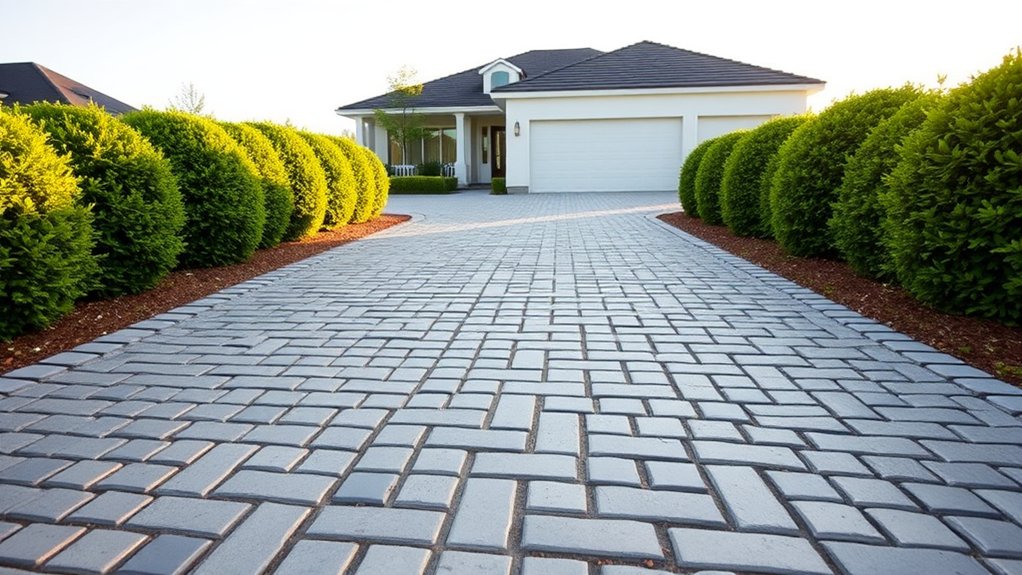
When it comes to the longevity and durability of a driveway, several factors play a crucial role in determining its lifespan. Key elements include the choice of materials, installation methods, climate conditions, and maintenance practices.
| Factor | Impact on Longevity | Key Considerations |
|---|---|---|
| Driveway Materials | Varies (Concrete > Tarmac) | Consider durability and upkeep needs |
| Installation Techniques | Essential for stability | Follow best practices and guidelines |
| Climate Conditions | Influences wear and tear | Be mindful of frost and heat effects |
| Maintenance Practices | Helps prevent larger problems | Regular cleaning and sealing are vital |
| Usage and Traffic Load | Affects material selection | Design for the expected level of traffic |
Frequently Asked Questions
Can I Build a Driveway Without a Permit?
In the UK, you generally can’t build a driveway without a permit due to local planning regulations. It’s crucial to check your local council’s guidelines, as neglecting to secure the necessary permissions could result in fines or the requirement to alter your work. For instance, if your driveway affects drainage or access, you may need to apply for planning permission. Always ensure you’re compliant to avoid potential issues down the line.
What Are the Costs Associated With Wider Driveways?
When thinking about wider driveways, it’s important to consider the installation costs, including materials and labour. Larger dimensions will significantly increase both of these expenses, impacting your overall budget. For example, opting for block paving instead of tarmac can change the cost dynamics. Careful planning and wise material choices can help you keep these costs in check.
How Does Driveway Width Affect Drainage?
Think of your driveway’s width like a modern sponge. A wider driveway leads to more water runoff, which means you’ll need effective drainage solutions to handle the increased flow and prevent water pooling. This is crucial for keeping your property safe and structurally sound. For instance, if your driveway is wide and it rains heavily, without proper drainage, water can accumulate and cause issues like flooding or damage to your foundations.
Are There Any Environmental Regulations for Driveways?
Yes, it’s important to consider environmental regulations when choosing materials for your driveway. These regulations help manage potential environmental impacts, such as reducing runoff, maintaining soil permeability, and protecting local ecosystems. For instance, opting for permeable paving can allow rainwater to drain naturally, preventing flooding and preserving groundwater. Adhering to these guidelines is crucial for promoting sustainable development.
Can I Use Permeable Materials for My Driveway?
Think of your driveway like a sponge that soaks up rainwater. Using permeable materials for your driveway is a great option. It supports sustainability, manages stormwater effectively, and positively impacts your property’s environment. For instance, permeable paving allows rain to drain through, reducing puddles and preventing flooding.
Conclusion
Navigating driveway width regulations can be tricky, but knowing the details makes it easier. Make sure to consider minimum requirements, safety, and visual appeal to ensure your driveway complies with local rules. A well-designed driveway is more than just a way to park; it’s the first impression of your home. Keep these points in mind to create a functional and attractive entry that lasts.
Know the essential steps to secure planning permission for your tarmac driveway—discover key insights that could save you time and Read more
Comprehend the essential UK driveway regulations to ensure compliance and discover key factors that could impact your project and budget. Read more
Can you install a driveway without planning permission? Consider size, materials, and regulations—discover what you need to know before starting Read more

